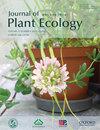菌根真菌减少适合度差异,但共存是由植物内在菌根响应性的差异决定的
IF 3.9
2区 环境科学与生态学
Q2 ECOLOGY
引用次数: 0
摘要
植物-丛枝菌根真菌(AMF)联合可以介导竞争植物之间的土壤资源,影响植物资源的捕获和适应性,使AMF成为植物共存的潜在因素。我们通过生态位和适应度差异评估了植物共存,使用了六种不同菌根状态的植物。我们将该物种培育成15对具有或不具有AMF的竞争配对。AMF对共存的影响是通过参数化成对的Lotka–Volterra植物竞争模型来确定的。通过将在没有任何AMF竞争的情况下生长的单个植物的地上部生物量与没有AMF的地上部生物质进行比较来确定六种植物对AMF的响应。接种AMF降低了竞争对手之间的适应度差异,但AMF介导的共存程度取决于竞争植物物种的身份。竞争植物物种之间AMF反应差异越大,生态位重叠减少,共存增加。这些结果表明,虽然AMF通常会减少适应度差异,但AMF的均衡效应并不总是足够强,无法克服由于生态位重叠造成的竞争失衡,因此并不总是导致共存。相反,不同植物物种对AMF的内在生长反应可以预测生态位重叠的减少,从而导致共存。这意味着菌根依赖是一种植物策略,旨在减少与竞争对手的生态位重叠,从而实现更大的共存。本文章由计算机程序翻译,如有差异,请以英文原文为准。
Mycorrhizal fungi reduce fitness differences, but coexistence is determined by differences in intrinsic plant mycorrhizal responsiveness
Plant–arbuscular mycorrhizal fungal (AMF) associations can mediate soil resources among competing plants to influence plant resource capture and fitness, making AMF a potential agent of plant coexistence. We assessed plant coexistence, via niche and fitness differences, using six plant species varying in their mycorrhizal status. We grew the species in 15 competitive pairs with or without AMF. Effects of AMF on coexistence were determined by parametrising pairwise Lotka–Volterra plant competition models. Responses of the six plant species to AMF were determined by comparing the shoot biomass of single plants grown in the absence of any competition with AMF to the shoot biomass without AMF. The inoculation with AMF reduced the fitness differences between competitors, but the degree of AMF-mediated coexistence depended on the identity of the competing plant species. A greater AMF response difference between competing plant species reduced niche overlap and increased coexistence. These results show that while AMF generally reduce fitness differences, the equalizing effect of AMF is not always strong enough to overcome a competitive imbalance due to niche overlap and thus does not always lead to coexistence. Instead, it is the intrinsic growth response of different plant species to AMF can predict reduced niche overlap that in turn leads to coexistence. This implies that mycorrhizal dependence is a plant strategy to reduce niche overlap with competitors allowing for greater coexistence.
求助全文
通过发布文献求助,成功后即可免费获取论文全文。
去求助
来源期刊

Journal of Plant Ecology
生物-植物科学
CiteScore
4.60
自引率
18.50%
发文量
134
审稿时长
3 months
期刊介绍:
Journal of Plant Ecology (JPE) serves as an important medium for ecologists to present research findings and discuss challenging issues in the broad field of plants and their interactions with biotic and abiotic environment. The JPE will cover all aspects of plant ecology, including plant ecophysiology, population ecology, community ecology, ecosystem ecology and landscape ecology as well as conservation ecology, evolutionary ecology, and theoretical ecology.
 求助内容:
求助内容: 应助结果提醒方式:
应助结果提醒方式:


